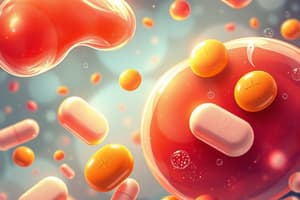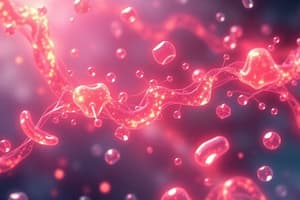Podcast
Questions and Answers
What is the mechanism of action of ezetimibe?
What is the mechanism of action of ezetimibe?
- Inhibits the selective-cholesterol transporter NPC1L1 (correct)
- Activates PPAR-α
- Stimulates liver to up-regulate LDL-R
- Inhibits lipoprotein lipase activity
Which drug is used as monotherapy in mild cases of hypercholesterolemia?
Which drug is used as monotherapy in mild cases of hypercholesterolemia?
- Ezetimibe (correct)
- Niacin
- Omega-3 fatty acids
- Statins
What is the main effect of fibrates on HDL-C levels?
What is the main effect of fibrates on HDL-C levels?
- No effect on HDL-C
- Increase HDL-C (correct)
- Decrease HDL-C
- Convert HDL-C to LDL-C
In what type of patients are statins never given?
In what type of patients are statins never given?
Which drug is used cautiously in patients under 18 years of age?
Which drug is used cautiously in patients under 18 years of age?
What is the net effect of fibrates on triglycerides and VLDL?
What is the net effect of fibrates on triglycerides and VLDL?
Which drug is mainly given as an adjuvant to statins in resistant cases of hypercholesterolemia?
Which drug is mainly given as an adjuvant to statins in resistant cases of hypercholesterolemia?
'PPAR-α Agonists' like fibrates modulate gene expression of all the following EXCEPT:
'PPAR-α Agonists' like fibrates modulate gene expression of all the following EXCEPT:
What is the main classification method for statins based on lipid solubility?
What is the main classification method for statins based on lipid solubility?
Which type of statins has a higher tendency to induce myopathy?
Which type of statins has a higher tendency to induce myopathy?
How do statins mainly modulate the lipid profile?
How do statins mainly modulate the lipid profile?
Which of the following is a major concern when taking lipophilic statins?
Which of the following is a major concern when taking lipophilic statins?
What is the primary method of diagnosis for myopathy induced by statins?
What is the primary method of diagnosis for myopathy induced by statins?
How are hydrophilic statins eliminated from the body?
How are hydrophilic statins eliminated from the body?
What is the primary impact of statins on total cholesterol and LDL-C levels?
What is the primary impact of statins on total cholesterol and LDL-C levels?
Which aspect of lipid profile is mainly increased by statins?
Which aspect of lipid profile is mainly increased by statins?
Which of the following is true about Omega-3 Fatty Acids?
Which of the following is true about Omega-3 Fatty Acids?
What is the mechanism of action of Niacin (Nicotinic Acid) in adipose tissue?
What is the mechanism of action of Niacin (Nicotinic Acid) in adipose tissue?
What is a characteristic of Adjuvant therapy in Hypertriglyceridemia?
What is a characteristic of Adjuvant therapy in Hypertriglyceridemia?
Which statement about Cholestyramine is correct?
Which statement about Cholestyramine is correct?
Why should Fibrates be used cautiously in renal impairment?
Why should Fibrates be used cautiously in renal impairment?
What effect does Omega-3 Fatty Acids have on the cell membrane?
What effect does Omega-3 Fatty Acids have on the cell membrane?
What are the common side effects of Niacin?
What are the common side effects of Niacin?
How can the side effects of Niacin, such as pruritus and flushing, be avoided?
How can the side effects of Niacin, such as pruritus and flushing, be avoided?
In what condition is Niacin better avoided?
In what condition is Niacin better avoided?
How does Cholestyramine help in lowering hypertriglyceridemia and hypercholesterolemia?
How does Cholestyramine help in lowering hypertriglyceridemia and hypercholesterolemia?
What is a major drawback in using Cholestyramine for treatment?
What is a major drawback in using Cholestyramine for treatment?
Which lipid parameter does Cholestyramine primarily target for reduction?
Which lipid parameter does Cholestyramine primarily target for reduction?
What can be a potential solution to the issue of Cholestyramine adsorbing to fat-soluble vitamins?
What can be a potential solution to the issue of Cholestyramine adsorbing to fat-soluble vitamins?
What is a common side effect that Niacin can induce when combined with statins or fibrates?
What is a common side effect that Niacin can induce when combined with statins or fibrates?
Which of the following is NOT classified as an anti-hypercholesterolemic agent according to the text?
Which of the following is NOT classified as an anti-hypercholesterolemic agent according to the text?
What is the mechanism of action of statins according to the text?
What is the mechanism of action of statins according to the text?
Which drug is classified as a mixed anti-dyslipidemic agent?
Which drug is classified as a mixed anti-dyslipidemic agent?
How do statins reduce blood cholesterol levels according to the text?
How do statins reduce blood cholesterol levels according to the text?
Which agent exerts its action by inhibiting PPAR- according to the text?
Which agent exerts its action by inhibiting PPAR- according to the text?
When considering adjuvant therapy in hypertriglyceridemia, what drug class can be used with statins according to the text?
When considering adjuvant therapy in hypertriglyceridemia, what drug class can be used with statins according to the text?
Which agent aims to elevate HDL levels based on the text?
Which agent aims to elevate HDL levels based on the text?
Flashcards are hidden until you start studying
Study Notes
Anti-Dyslipidemic Agents
- Classified into three groups: anti-hypercholesterolemic agents, anti-hypertriglyceridemic agents, and mixed anti-dyslipidemic agents
Statins
- Inhibit cholesterol synthesis in the liver by reversible competitive inhibition of the rate-limiting step of its formation
- Upregulate LDL-Receptors, reducing circulating cholesterol levels
- Classified according to lipid solubility into hydrophilic, lipophilic, or mixed
- Hydrophilic agents are eliminated by the kidney and have minimal drug interactions
- Lipophilic agents are metabolized by the liver and have many drug interactions
- Can cause dose-dependent elevation in hepatic enzymes and induce myopathy
- Used to treat dyslipidemia, especially hypercholesterolemia
- Can improve glucose tolerance and suppress serum uric acid
Ezetimibe
- Selective cholesterol absorption inhibitor
- Inhibits exogenous cholesterol intake, stimulating the liver to upregulate LDL-R
- Given as monotherapy in mild cases of hypercholesterolemia or as an adjuvant to statins in resistant cases
- Has a safe profile
Fibrates
- PPAR-α agonists
- Modulate gene expression, decreasing triglycerides and VLDL, and increasing HDL-C
- Involved in inflammatory reactions, especially those linked to cholesterol accumulation
- Classified according to lipid solubility and duration of action
- Can be used in combination with statins, but caution is needed to avoid myopathy
- Fibrates are never given during pregnancy and are used cautiously in renal and hepatic impairment
Omega-3 Fatty Acids
- Polyunsaturated fatty acids derived from fatty fish oil
- Possess a weak PPAR-α agonistic effect
- Inhibit platelet aggregation and are cardio-protective
- Used as adjuvant therapy in hypertriglyceridemia
Niacin
- Vitamin B3 that acts on a specific receptor in adipose tissue to inhibit hormone-sensitive lipase
- Decreases lipolysis and availability of FFA for TG synthesis in the liver
- Activates lipoprotein lipase to increase VLDL circulatory clearance
- Increases HDL-C by decreasing clearance of Apo A from plasma
- Used as mono therapy or in combination with other anti-dyslipidemic agents
- Can cause pruritus, sensation of warmth, and flushing, which can be avoided by using aspirin or slow-release formulations
Cholestyramine
- Bile acid sequestrant that adsorbs bile acids and eliminates them in stools
- Enhances uptake of circulating LDL to eliminate endogenous cholesterol
- Used to lower hypertriglyceridemia, hypercholesterolemia, or in mixed dyslipidemia
- Can be given as monotherapy or in combination with other anti-dyslipidemic agents
- Has a drawback of adsorbing steroids and fat-soluble vitamins, which must be replaced as supplements
Studying That Suits You
Use AI to generate personalized quizzes and flashcards to suit your learning preferences.




